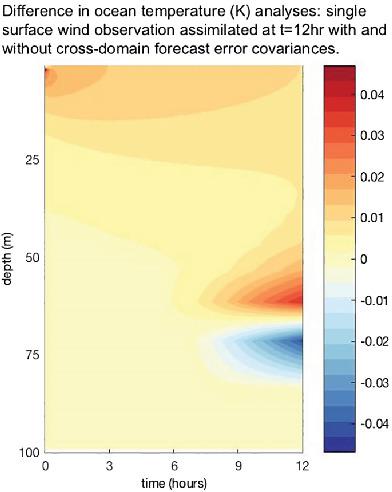当前位置:
X-MOL 学术
›
Q. J. R. Meteorol. Soc.
›
论文详情
Our official English website, www.x-mol.net, welcomes your
feedback! (Note: you will need to create a separate account there.)
The role of cross‐domain error correlations in strongly coupled 4D‐Var atmosphere–ocean data assimilation
Quarterly Journal of the Royal Meteorological Society ( IF 3.0 ) Pub Date : 2020-05-11 , DOI: 10.1002/qj.3802 Polly J. Smith 1 , Amos S. Lawless 1, 2 , Nancy K. Nichols 1, 2
Quarterly Journal of the Royal Meteorological Society ( IF 3.0 ) Pub Date : 2020-05-11 , DOI: 10.1002/qj.3802 Polly J. Smith 1 , Amos S. Lawless 1, 2 , Nancy K. Nichols 1, 2
Affiliation

|
Strongly coupled atmosphere–ocean data assimilation offers the ability to improve information exchange across the modelled air‐sea interface by enabling observations in one domain to have a direct influence on the analysis in the other. For incremental 4D‐Var assimilation a strongly coupled approach enables both domains to be updated at the beginning of the assimilation window, whether they are observed or not, and is hence more likely to produce consistent initial model states. This is made possible by the explicit inclusion of cross‐domain forecast error covariance information in the coupled forecast error covariance matrix. In this study we use an idealised 1D single‐column coupled atmosphere–ocean model to examine the extent to which explicit cross‐domain forecast error covariances play a role in shaping the coupled analysis increments compared to those implicitly generated in the inner‐loop of the incremental formulation of the 4D‐Var algorithm. This is done via a set of single‐observation experiments with and without initial cross‐domain forecast error covariances prescribed. Using single observations allows us to obtain explicit expressions for the atmosphere and ocean analysis updates, separating out the individual effects of the explicitly prescribed and implicitly generated cross‐domain covariances. Our experiments show that when only one domain is observed, including explicit cross‐domain error covariances allows more consistent adjustment of the unobserved domain. Neglecting the cross‐domain terms and relying solely on the covariances implicitly generated by the coupled tangent linear and adjoint models restricts the ability of the covariance matrix to impose balance between the two domains. In this case the coupling is essentially one‐way; the update to the observed domain is independent of the unobserved domain and so is likely to produce atmosphere and ocean updates that are inconsistent with one another. As we show, this has important consequences for the balance of the coupled analysis state.
中文翻译:

跨域误差相关在强耦合4D-Var大气-海洋数据同化中的作用
强耦合的大气-海洋数据同化通过使一个域中的观测对另一域中的分析产生直接影响,从而能够改善跨建模的海-海界面的信息交换。对于增量4D-Var同化,无论是否观察到,都可以通过强耦合方法使两个域都在同化窗口的开头进行更新,因此更有可能产生一致的初始模型状态。通过在耦合的预测误差协方差矩阵中明确包含跨域预测误差协方差信息,可以实现这一点。在这项研究中,我们使用理想化的一维单柱耦合大气-海洋模型来检验显性跨域预测误差协方差在塑造耦合分析增量中所起的作用(与隐含生成在海洋内部环中的那些相比)的程度。 4D-Var算法的增量公式化。这是通过一组单观测实验完成的,其中规定了初始跨域预测误差的协方差,也没有规定。使用单个观测值可以使我们获得大气和海洋分析更新的显式表达式,从而分离出明确规定的和隐式生成的跨域协方差的各个影响。我们的实验表明,仅观察到一个域时,包括明确的跨域误差协方差,可以更一致地调整未观察域。忽略跨域项并仅依靠耦合切线线性和伴随模型隐式生成的协方差会限制协方差矩阵在两个域之间施加平衡的能力。在这种情况下,耦合本质上是单向的。观测域的更新独立于未观测域,因此可能产生彼此不一致的大气和海洋更新。如我们所示,这对耦合分析状态的平衡具有重要的影响。忽略跨域项并仅依靠耦合切线线性和伴随模型隐式生成的协方差会限制协方差矩阵在两个域之间施加平衡的能力。在这种情况下,耦合本质上是单向的。观测域的更新独立于未观测域,因此可能产生彼此不一致的大气和海洋更新。如我们所示,这对耦合分析状态的平衡具有重要的影响。忽略跨域项并仅依靠耦合切线线性和伴随模型隐式生成的协方差会限制协方差矩阵在两个域之间施加平衡的能力。在这种情况下,耦合本质上是单向的。观测域的更新独立于未观测域,因此可能产生彼此不一致的大气和海洋更新。如我们所示,这对耦合分析状态的平衡具有重要的影响。
更新日期:2020-05-11
中文翻译:

跨域误差相关在强耦合4D-Var大气-海洋数据同化中的作用
强耦合的大气-海洋数据同化通过使一个域中的观测对另一域中的分析产生直接影响,从而能够改善跨建模的海-海界面的信息交换。对于增量4D-Var同化,无论是否观察到,都可以通过强耦合方法使两个域都在同化窗口的开头进行更新,因此更有可能产生一致的初始模型状态。通过在耦合的预测误差协方差矩阵中明确包含跨域预测误差协方差信息,可以实现这一点。在这项研究中,我们使用理想化的一维单柱耦合大气-海洋模型来检验显性跨域预测误差协方差在塑造耦合分析增量中所起的作用(与隐含生成在海洋内部环中的那些相比)的程度。 4D-Var算法的增量公式化。这是通过一组单观测实验完成的,其中规定了初始跨域预测误差的协方差,也没有规定。使用单个观测值可以使我们获得大气和海洋分析更新的显式表达式,从而分离出明确规定的和隐式生成的跨域协方差的各个影响。我们的实验表明,仅观察到一个域时,包括明确的跨域误差协方差,可以更一致地调整未观察域。忽略跨域项并仅依靠耦合切线线性和伴随模型隐式生成的协方差会限制协方差矩阵在两个域之间施加平衡的能力。在这种情况下,耦合本质上是单向的。观测域的更新独立于未观测域,因此可能产生彼此不一致的大气和海洋更新。如我们所示,这对耦合分析状态的平衡具有重要的影响。忽略跨域项并仅依靠耦合切线线性和伴随模型隐式生成的协方差会限制协方差矩阵在两个域之间施加平衡的能力。在这种情况下,耦合本质上是单向的。观测域的更新独立于未观测域,因此可能产生彼此不一致的大气和海洋更新。如我们所示,这对耦合分析状态的平衡具有重要的影响。忽略跨域项并仅依靠耦合切线线性和伴随模型隐式生成的协方差会限制协方差矩阵在两个域之间施加平衡的能力。在这种情况下,耦合本质上是单向的。观测域的更新独立于未观测域,因此可能产生彼此不一致的大气和海洋更新。如我们所示,这对耦合分析状态的平衡具有重要的影响。











































 京公网安备 11010802027423号
京公网安备 11010802027423号